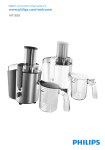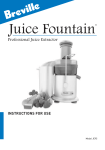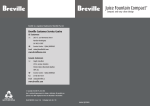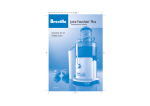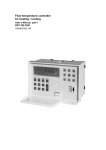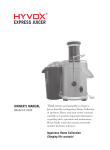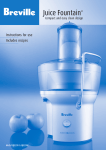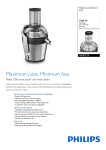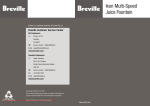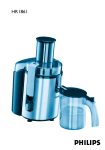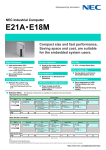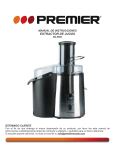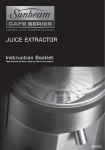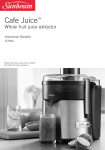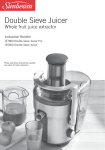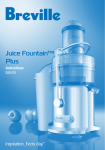Download www.philips.com/welcome
Transcript
Register your product and get support at www.philips.com/welcome HR1871 1 HR1871 English 6 Deutsch 14 Ελληνικα 22 Español 31 Français 39 Italiano 47 Nederlands 55 Português 63 Türkçe 71 6 English Introduction Congratulations on your purchase and welcome to Philips! To fully benefit from the support that Philips offers, register your product at www.philips.com/welcome. This juicer has been designed to maximise the juice output while minimising the cleaning effort. It has been specifically developed to enable you to process a broad variety of ingredients and a wide range of recipes with confidence. General description (Fig. 1) A B C D E F G H I J K L M N O P Pusher Feeding tube Lid Filter Juice collector with spout Pulp window Integrated pulp container Driving shaft Locking arm Motor unit Control knob Cord storage compartment Detachable spout with drip stop function Spout accessory Juice jug Juice jug lid with integrated foam separator Important Read this user manual carefully before you use the appliance and save it for future reference. Danger -- Do not immerse the motor unit in water or any other liquid, nor rinse it under the tap. -- Do not clean the motor unit in the dishwasher. Warning -- Check if the voltage indicated on the base of the appliance corresponds to the local mains voltage before you connect the appliance. -- Do not use the appliance if the plug, the mains cord or other components are damaged. -- If the mains cord is damaged, you must have it replaced by Philips, a service centre authorised by Philips or similarly qualified persons in order to avoid a hazard. -- This appliance is not intended for use by persons (including children) with reduced physical, sensory or mental capabilities, or lack of experience and knowledge, unless they have been given supervision or instruction concerning use of the appliance by a person responsible for their safety. -- Children should be supervised to ensure that they do not play with the appliance. -- Never let the appliance operate unattended. -- If you detect cracks in the filter or if the filter is damaged in any way, do not use the appliance anymore and contact the nearest Philips service centre. -- Never reach into the feeding tube with your fingers or an object while the appliance is running. Only use the pusher for this purpose. -- Do not touch the small cutting blades in the base of the filter. They are very sharp. English 7 Caution -- This appliance is intended for household use only. -- Do not hold the appliance by the locking arm when you carry it. -- Never use any accessories or parts from other manufacturers or that Philips does not specifically recommend. If you use such accessories or parts, your guarantee becomes invalid. -- Make sure all parts are correctly assembled before you switch on the appliance. -- Only use the appliance when the locking arm is in locked position. -- Only lower the locking arm to unlocked position after you have switched off the appliance and the filter has stopped rotating. -- Do not operate the juicer for more than 40 seconds at a time when you juice heavy loads and let it cool down sufficiently afterwards. None of the recipes in this user manual constitute heavy loads. -- Always unplug the appliance after use. Safety feature -- This juicer is fitted with a safety feature which safeguards against overheating due to excessive loads. In case of overheating, the juicer automatically activates the overload protection and switches itself off. If this occurs, set the control knob to 0, unplug the appliance and allow it to cool down for 15 minutes. Remove the juice jug and detach the lid, juice collector and the integrated pulp container and then press the overload protection button on the bottom of the motor unit (Fig. 2). Electromagnetic fields (EMF) This Philips appliance complies with all standards regarding electromagnetic fields (EMF). If handled properly and according to the instructions in this user manual, the appliance is safe to use based on scientific evidence available today. Preparing for use 1Make sure all detachable parts are clean (see chapter ‘Cleaning’) and assembled correctly. 2Unwind the mains cord from the base of the motor unit (Fig. 3). 3Assemble the integrated pulp container onto motor unit (Fig. 4). 4Assemble the juice collector onto the integrated pulp container (Fig. 5). 5Assemble the filter onto the driving shaft of the motor unit. Make sure the filter is fitted securely onto the driving shaft (‘click’) (Fig. 6). 6Assemble the lid onto the juicer (Fig. 7). 7Lift the locking arm to locked position (‘click’) (Fig. 8). 8Place the lid on the juice jug to avoid spattering (Fig. 9). Note:The integrated foam separator ensures clear juice as an end result. 9Place the juice jug under the spout (Fig. 10). Note: If you want to extract juice straight into a glass, use the spout accessory (Fig. 11). 10Turn the spout to the flow position before you start juicing (Fig. 12). 8 English Using the appliance The appliance only functions if all parts are assembled correctly and the locking arm is in locked position. 1Wash the fruit and/or vegetables and cut them, if necessary, into pieces that fit into the feeding tube. 2Make sure the juice jug is placed directly under the spout (Fig. 10). 3Make sure the spout is in the flow position (Fig. 12). 4Turn the control knob to setting 1 (low speed) or 2 (normal speed) to switch on the appliance (Fig. 13). Note: For hard fruits/vegetables (e.g. apples, beetroots and carrots) we advise you to use speed 2 (normal speed). For soft fruits (e.g. berries, kiwi, grapes, tomatoes, cucumber and melon) we advise you to use speed 1 (low speed). 5Put the pieces in the feeding tube and gently press them down towards the rotating filter with the pusher (Fig. 14). Do not exert too much pressure on the pusher, as this could affect the quality of the end result. It could even cause the filter to come to a halt. Never insert your fingers or an object into the feeding tube. 6Align the groove of the pusher with the small protrusion on the inside of the feeding tube and slide the pusher into the feeding tube (Fig. 14). 7When you have processed all ingredients or when the integrated pulp container is full, switch off the appliance and unplug it. Wait until the filter stops rotating. 8Set the spout to the drip stop position to prevent juice from dripping (Fig. 15). Note:The drip stop function only works if the appliance is switched off and the spout is set to the drip stop position. 9To empty the integrated pulp container, remove the lid, the filter and the juice collector. 10For maximum flavour and freshness, serve the juice immediately after preparation. Note: If you want to store the juice in the refrigerator, make sure the lid is on the juice jug. Tips Preparation -- To extract the maximum amount of juice, always press the pusher down slowly. -- Use fresh fruit and vegetables, as they contain more juice. Pineapples, beetroots, celery stalks, apples, cucumbers, carrots, spinach, melons, tomatoes, oranges and grapes are particularly suitable for processing in the juicer. -- The juicer is not suitable for processing very hard and/or fibrous or starchy fruits or vegetables such as sugar cane. -- Leaves and leaf stalks of e.g. lettuce can also be processed in the juicer. -- Remove stones from cherries, plums, peaches, etc. You do not have to remove cores or seeds from fruits like melons, apples and grapes. -- You do not have to remove thin peels or skins. Only remove thick peels that you would not eat, e.g. those of oranges, pineapples, kiwis, melons and uncooked beetroots. -- When you prepare apple juice, take into consideration that the thickness of the apple juice depends on the kind of apple you use. The juicier the apple, the thinner the juice. Choose a kind of apple that produces the type of juice you prefer. English 9 -- If you want to process citrus fruits with the juicer, remove the peel as well as the white pith. The white pith gives juice a bitter taste. -- Fruits that contain starch, such as bananas, papayas, avocados, figs and mangoes are not suitable for processing in the juicer. Use a food processor, blender or hand blender to process these fruits. Serving -- Drink the juice immediately after you have extracted it. If it is exposed to air for some time, the juice loses its taste and nutritional value. -- If you want clear juice without a foam layer, put the lid with integrated foam separator on the jug. If you want cloudy juice with a foam layer, remove the lid with integrated foam separator from the jug. -- Apple juice turns brown very quickly. To slow down this process, add a few drops of lemon juice. -- When serving cold drinks, add a few ice cubes. Fruit and vegetable facts Fruit/ vegetable Vitamins/minerals Kilojoule/calorie count Juicing speed Maximum quantity Apples Vitamin C 200g=150kJ (72 cals) high 3.5kg or 2.5l juice Apricots High in dietary fibre, contains potassium 30g=85kJ (20 cals) low 2.5kg or 1.5l juice Beetroot Good source of folate, dietary fibre, vitamin C and potassium 160g=190kJ (45 cals) high 1.5-2kg or 0.6l-1l juice Blueberries Vitamin C 125g=295kJ (70 cals) low 4kg or 2l juice Brussels sprouts Vitamin C, B, B6, E, folate and dietary fibre 100g=110kJ (26 cals) low 3.5kg or 2l juice Cabbage Vitamin C, folate, potassium, B6 and dietary fibre 100g=110kJ (26 cals) high 2.5kg or 1.2l juice Carrots Vitamin A, C, B6 and dietary fibre 120g=125kJ (30 cals) high 1.5-2kg or 0.6l-1l juice Celery Vitamin C and potassium 80g=55kJ (7 cals) high 1.5kg or 0.7 l juice Cucumber Vitamin C 280g=120kJ (29 cals) low 4.5kg or 3l juice Fennel Vitamin C and dietary fibre 300g=145kJ (35 cals) low 3.5kg or 2.5l juice Grapes Vitamin C, B6 and potassium 125g=355kJ (85 cals) low 4kg or 2.5l juice Kiwi fruit Vitamin C and potassium 100g=100kJ (40 cals) low 4kg or 2.5l juice 10 English Fruit/ vegetable Vitamins/minerals Kilojoule/calorie count Juicing speed Maximum quantity Melons Vitamin C, folate, dietary fibre and vitamin A 200=210kJ (50 cals) low 5kg or 3l juice at minimum Nectarines Vitamin C, B3, potassium and dietary fibre 180g=355kJ (85 cals) high 3.5kg or 2l Peaches Vitamin C, B3, potassium and dietary fibre 150g=205kJ (49 cals) high 3.5kg or 2l Pears Dietary fibre 150g=250kJ (60 cals) high 3.5kg or 2.5l juice Pineapples Vitamin C 150g=245kJ (59 cals) high 3kg or 2l juice Raspberries Vitamin C, iron, potassium and magnesium 125g=130kJ (31 cals) low 4kg or 2.5l juice Tomatoes Vitamin C, dietary fibre, vitamin E, folate and vitamin A 100g=90kJ (22 cals) low 4kg or 2.5l juice Depending on the ingredients used, you can prepare up to 2.5 liters of juice without emptying the integrated pulp container. The maximum amount of fruits and vegetables that can be juiced in one go is indicated in the table above. When juicing hard ingredients such as carrots or beetroots, the maximum amount of juice that can be extracted is up to 700ml (check the level indication on the juice jug). Note:When the integrated pulp container has reached its maximum capacity, pulp ends up in the juice collector, lid and the juice. If you overfill the integrated pulp container, the appliance becomes blocked. When this occurs, switch off the appliance and remove the pulp from the integrated pulp container. Note:The pulp window helps you to see when the integrated pulp container is full and needs to be emptied. Because the pulp window may become blocked before the maximum capacity of the container is reached, also check the level indication on the juice jug.The pulp window is more likely to become blocked when juicing hard ingredients, such as carrots or beetroots. Recipes Orange carrot juice Ingredients: -- 1kg carrots -- 4 oranges -- 1 tbsp olive oil -- 1 large fresh mint sprig (optional garnish) 1Peel the oranges. 2Process the carrots and oranges in the juicer. Note:This appliance can process 5kg of carrots in approx. 1 minute (not including the time required to remove the pulp).When you have processed 2.5 kg of carrots, switch off and unplug the appliance and English 11 remove the pulp from the integrated pulp container, the lid and filter.When you have finished processing the carrots, switch off the appliance and let it cool down to room temperature. 3Add a tablespoon olive oil and a few ice cubes to the juice. 4Mix well. 5Pour the juice into a glass. Tip: Add a fresh mint sprig to your glass as an optional garnish. Energy cocktail Ingredients: -- 2 carrots -- ½ cucumber -- 12 spinach leaves -- 1 lime, peeled -- 1 celery stick -- 1 apple -- 1 tomato -- 2 tablespoons honey 1Process all ingredients in the juicer except for the honey. 2When you have finished processing the ingredients, add honey to the juice and mix well. Cleaning and storage Never use scouring pads, abrasive cleaning agents or aggressive liquids such as alcohol, petrol or acetone to clean the appliance. The appliance is easier to clean if you do so immediately after use. 1Switch off the appliance. Remove the plug from the wall socket and wait until the filter has stopped rotating. 2Lower the locking arm to unlocked position (Fig. 16). 3To keep your kitchen clean, all detachable parts (integrated pulp container, juice collector, filter and lid) can be carried to the sink in one go (Fig. 17). 4Disassemble all detachable parts. 5To detach the detachable spout, turn it to the flow position and pull it off the juice collector spout (Fig. 18). 6Empty the integrated pulp container. 7Clean all detachable parts with a sponge or wet cloth in warm water with some washing-up liquid and rinse them under the tap. Note: All detachable parts are dishwasher-safe. Place the detachable plastic parts in the top tray of the dishwasher. Make sure they are placed well away from the heating element. 8Clean the motor unit with a damp cloth. Never immerse the motor unit in water nor rinse it under the tap. 12 English Storage 1Store the mains cord in the cord storage facility by winding it round the base of the motor unit. Caution: Do not hold the appliance by the locking arm when you carry it. Environment -- Do not throw away the appliance with the normal household waste at the end of its life, but hand it in at an official collection point for recycling. By doing this, you help to preserve the environment (Fig. 19). Guarantee and service If you need service or information or if you have a problem, please visit the Philips website at www.philips.com or contact the Philips Consumer Care Centre in your country (you find its phone number in the worldwide guarantee leaflet). If there is no Consumer Care Centre in your country, go to your local Philips dealer. Replacement How to order parts If you need to replace a part or want to purchase an additional part, go to your Philips dealer or visit www.philips.com/support. If you have problems obtaining the parts, please contact the Philips Consumer Care Centre in your country. Troubleshooting This chapter summarises the most common problems you could encounter with the appliance. If you are unable to solve the problem with the information below, contact the Consumer Care Centre in your country. Problem Solution The appliance does not work. The appliance is equipped with a safety system. If the parts have not been assembled correctly, the appliance does not work. Switch off the appliance and check whether the parts have been assembled in the right way. The appliance stops during use. The juicer is overheated. Switch off and unplug the appliance. Remove the pulp from the integrated pulp container. Wait until the appliance has cooled down. Then press the overload protection button on the bottom of the motor unit. The appliance slows down during use. The integrated pulp container has reached its maximum capacity. Switch off the appliance and remove the pulp from the integrated pulp container. The appliance makes a It is common for a new appliance to produce an unpleasant smell or emit a little smoke when it is first used. The phenomenon stops after you lot of noise, gives off an unpleasant smell, is have used the appliance a few times. too hot to touch, gives off smoke etc. English 13 Problem Solution The appliance is blocked. Check if any fruit or vegetable is stuck in the filter. If so, switch off the appliance, remove the stuck part and start juicing again. The appliance may produce an unpleasant smell or emit some smoke if it has been used to process excessive loads. In that case, switch off the appliance and let it cool down for 60 minutes. If the problem persists, contact the Philips Consumer Care Centre in your country. The filter is blocked. Switch off the appliance, clean the feeding tube and the filter and process a smaller quantity. The filter touches the feeding tube or vibrates strongly during processing. Switch off and unplug the appliance. Check if the filter is placed properly in the juice collector. The ribs in the bottom of the filter have to fit properly onto the driving shaft. Check if the filter is damaged. Cracks, crazes, a loose grating disc or any other irregularity may cause malfunction. If you detect any cracks or damage in the filter, do not continue to use the appliance and contact the Philips Consumer Care Centre in your country for replacement of the filter. 2 3 4 5 6 7 8 9 1 0 2 10 11 12 13 14 15 16 17 18 19 4222.005.0197.1















